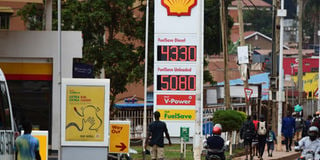Prime
Why fuel prices are still high

A fuel price display board at Shell fuel station in Kibuli, Kampala, on February 17, 2022. PHOTOs / ABUBAKER LUBOWA
What you need to know:
- Experts say motorists must understand the current pricing to avoid suppliers who are trying to profiteer from the current crisis.
- Fuel is a complementary product, therefore, any movements will have wider implications that might carry along inflationary pressures.
After weeks of fuel prices rising, government suspended the testing of truck drivers for Covid-19 at the border, which it blamed for the crisis.
Last month government revealed that it had sorted out fuel supply challenges, adding that pump prices would normalise.
However, nearly a month after the proclamation, pump prices are still above Shs5,000, which is an average increase of Shs400 from the price before the crisis hit the country at the close of 2021.
A mini survey by Monitor yesterday revealed that the average pump price for petrol is Shs5,080 per litre while diesel is Shs4,330.
Fuel prices began rising in July 2021 from Shs3,700 for petrol and Shs3,200. By December 2021, a litre of petrol cost Shs4, 580 yet demand was low due to restrictions of certain sectors of the economy.
During the 2021/2022 Financial Year, government increased excise duty on fuel from Shs1,350 to Shs1,450 per litre of petrol. The tax on diesel rose from Shs1,030 to Shs1,130 per litre.
Experts say this is partly to blame for high pump price but it is not enough to explain the sharp increase in the last two months, which some believe is spurred by price manipulation.
Early this month, the State Minister for Minerals, Mr Peter Lokeris, told Parliament that fuel prices would normalise mid-February.
However, there is still no sign that fuel prices will come down anytime soon.
Dr Patricia Litho, the head of communication at the Ministry of Energy and Mineral Development, said the oil prices have gone up on the global market and this has not helped Uganda’s situation.

A fuel display board showing fuel prices at Total in Kibuli, Kampala, on February 17, 2022.
“Even when we negotiate with our service providers, we have got to look at how much they can actually procure or buy,” Dr Litho said.
She added that much as the issues at the border have been addressed, the initial projection for prices to go down is not working out because of the global trends.
Mr Hans Paulsen, the Vivo Energy executive vice president East and Southern Africa, said: “[The fuel prices] have gone up drastically in the last 12 months by about 70 percent, returning to levels we last saw in 2013-2014.”
Mr Paulsen added that this was due to a spike in demand following the full reopening of global economies.
“During the lockdowns there was excess product on the market and low demand in the world. However, what has surprised everyone is the speed at which the global economies have bounced back [now that] restrictions [have been] lifted,” he notes.
Geo-politics
Experts have also blamed the rising fuel prices on the ongoing tension between Russia and Ukraine.
Citibank Global Oil expert Fransesco Martoccia said the tension over Ukraine has accounted for an additional $10 (Shs35,000) per barrel of fuel pushing the prices above $90 (Shs316,000). Were it not for that factor, prices were expected at around $80 (Shs281,000) per barrel.

The fuel prices at Mogas fuel station in Namugongo, Kampala, on February 17, 2022
Martoccia added that if the war in Ukraine does not happen, the resuscitation of the Iranian nuclear deal with US and the EU, which collapsed during the Donald Trump era, will add crude oil supply to the world market. But even if Iran adds its supply to the world market, Iranian oil is expected not earlier than April or May.
“What happens if there is an Iranian deal? In our opinion, crude oil prices will retreat to potentially $80 per barrel,” he said.
This leaves the January to March quarter still tight in terms of prices. Global oil orders are made in quarters and if the April to June quarter is preceded by rising crude oil prices, even if the Ukranian tensions are solved, the lag effect of high prices will carry on until June. For the local pump prices, any fall in price may, therefore, not be anytime soon.
Mr Paulsen says because of this, the global price of fuel has been affected to levels nearing $100 (Shs351,000) per barrel, and warns that “because of this, customers will continue to see pump prices going up”.
Regional status
Unlike Uganda, where prices are determined by market forces, in Kenya and Rwanda prices are controlled.
The controls are usually supported by subsidies that help to keep prices within affordable amounts even when there are global challenges.
READ MORE:




